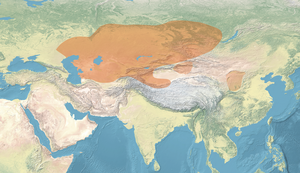| Geographical range | Western Mongolia |
|---|---|
| Dates | 7th to 3rd centuries BC |
| Preceded by | Deer stones culture |
| Followed by | Xiongnu |
The Chandman culture, also known as Chandmani culture, was a nomadic culture that existed in northwestern Mongolia and southern Siberia during the Iron Age, and is also known as the "Sagly-Bazhy culture" on the Russian side of the frontier. It is associated with the Eastern Scythian/Saka horizon, and is part of the more general Saka Uyuk culture.[1]
- ^ Jeong, Choongwon (12 November 2020). "A Dynamic 6,000-Year Genetic History of Eurasia's Eastern Steppe". Cell. 183 (4): 890–904. doi:10.1016/j.cell.2020.10.015. hdl:21.11116/0000-0007-77BF-D. ISSN 0092-8674.
The Sagly/Uyuk site of Chandman Mountain (...) Together with the Pazyryk of the Altai and the Saka of eastern Kazakhstan, they formed part of a broader Scythian cultural phenomenon that stretched across the Western Steppe, Tarim Basin, and Upper Yenesei


